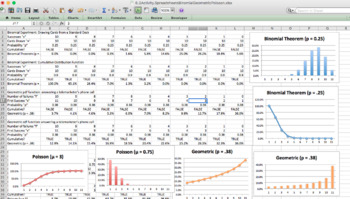Statistics Spreadsheet Activity - Binomial, Geometric, Poisson (2 days)
- Zip
- Excel Spreadsheets
Description
Statistics Spreadsheet Activity - Binomial, Geometric, Poisson (2 days)
This is a 1-2 day spreadsheet activity for a Statistics class. It uses spreadsheets as a walkthrough to allow students to explore the Binomial, Geometric, and Poisson distributions, as well as create graphs of the distributions. The product includes:
6.3 Spreadsheet Activity (Also included in " Statistics Unit 6 Bundle - Discrete Probability (12 days)" and in " A Mountain of Statistics Curriculum - One Full Year Bundle")
Excel xlsx and xls file formats
Teacher instructions
Answer Key included.
*The topics covered are binomial, geometric, and poisson distributions. The documents are Excel Based, pdfs included, and completely editable. Enjoy!
**If you find this product useful, consider buying the bundle for the entire class**
***Please read the "readme" text file and End User License Agreement contained in the Product. Thank you for respecting my work***




